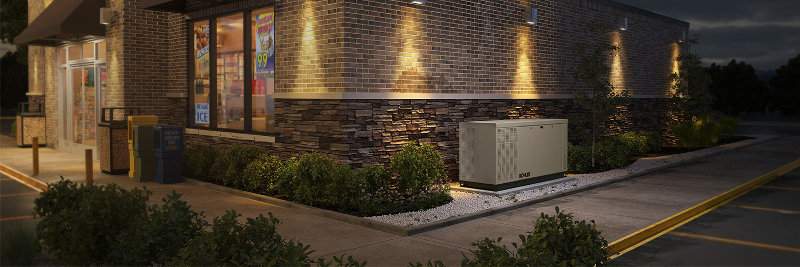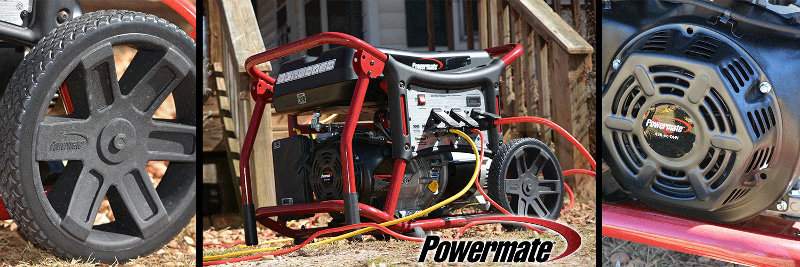Liquid Cooled vs Air Cooled Generator - A Homeowner's Buyer Guide

Homes and Businesses in a Hot Climate May Benefit from More Power and Fewer Heat-Related Shutdowns
A generator uses an internal combustion engine to turn an alternator. The alternator (generator) converts mechanical energy into electrical energy. The rapid expansion of hot gases inside the engine drive the pistons and turn the engine. Uncontrolled, the heat created by combustion and friction could damage the engine or the alternator. Generators must remove excess heat to prevent permanent engine damage.
This article examines the advantages of cooling methods employed to remove heat from a liquid-cooled or air-cooled generator.
Standby Generators: Understanding Terms and Concepts
Small engines typically allow heat to escape through cooling fins on the engine block and cylinder heads. The fins increase surface area which creates more contact with the air around the engine and allows the air to absorb some of the heat. This passive cooling works quite well for many small engines with enough difference in temperature between ambient air and the engine block.
Larger engines take longer to heat up which adds unburned fuel to the exhaust. An engine-driven fan pulls in outside air, blows it over the engine and alternator, and returns it outside. The cooling system is always functioning, even when the engine is cold. Many air-cooled standby generators with single or twin cylinder engines less than 1-liter (1000 cubic centimeters or cc) displacement employ this active cooling method.
Generator engines with a displacement larger than 1 liter employ a cooling system similar to that found in modern automobiles. The engine pumps liquid coolant through the engine and into a radiator. The coolant absorbs heat from the engine. A fan blows air through the radiator and transfers the heat to the air. This active method of cooling is very efficient and is employed in engines for cars, trucks, equipment, and liquid-cooled generators. A thermostat regulates the flow of coolant to help the engine warm up faster and then provides greater control over temperature while it runs.
Commercial Liquid-Cooled Generator Options
The Liquid Cooled Generator Advantage

An air-cooled engine depends on the transfer of heat from the engine to the air. A big difference in temperature allows the engine to transfer more heat to the surrounding air. Adding a fan allows faster heat transfer, but the transfer is limited by the temperature difference between the engine and the air.
Liquid coolant can absorb much more heat than the surrounding air. In the radiator, the liquid is given many times the surface than is possible on the engine surface. Large amounts of air blowing through the radiator remove heat fast and cool the liquid again on its path back to the engine. This advantage allows a liquid-cooled generator to operate in hot environments and still cool itself efficiently.
Engines work best at specific temperatures, especially diesel engines. A thermostat located in the cooling system opens and closes to allow or prevent coolant from circulating through the engine. As the engine nears optimum operating temperature, the thermostat opens to prevent the temperature from rising too high. If the coolant temperature falls, the thermostat begins to close.
A well-regulated operating temperature provides better combustion and lowers emissions.
Air Cooled Generator vs Liquid Cooled | What's the Difference?
Air Cooled Generator vs Liquid Cooled Generator

A liquid-cooled design is great for applications that require a larger, multi-cylinder engine or in locations where temperatures often exceed 100 degrees Fahrenheit. Someone living in the desert southwest may only need a 15kW generator. An air-cooled unit costs less but may experience frequent shutdowns due to overheating. A liquid-cooled generator solves the cooling problem.
In hot climates, the passive cooling of a hard-working portable generator may be inadequate. Overheating will shorten the generator life and cause premature failure. A portable liquid cooled generator may prove a better and more reliable choice.
Moderate climates like the Midwest, Northeast, or East Coast are well suited to air-cooled generators. They rarely have temperatures over 100 degrees. The average to large home in these regions generally requires less than 20 kilowatts of power, even with multiple air-conditioners. A smaller, fuel efficient air-cooled generator with a power management option meets the requirements of the home and family.
Multiple heavy loads may add up to more power than an air-cooled generator can provide. Luxury class homes with three or more air conditioners often need the power offered by liquid-cooled generators.
The frequency of AC current is directly related to engine speed. An alternator with a single pair of N and S poles runs at 3600 RPM for a frequency 60 hertz. This is the typical speed of many generators that run on natural gas, gasoline, or propane. Many larger generators and diesel generators operate at 1800 RPM and have an alternator with two pairs of N and S poles. Lower noise and longer engine life results.
The Best Liquid Cooled Generator for Hot Climates
Liquid Cooled Portable Generator

Portable with regard generators usually means it is not permanently installed in a single location. Generators on a jobsite provide power for tools, equipment, and buildings without access to an electric utility service. This may include remote locations, mines, or sites where utility service is not yet available. A new commercial building site or highway construction project, for example. Some air-cooled portables can do the job, but extended use over long period requires a generator rated for a prime power application.
An air-cooled portable might be light enough to lift off the back of a pickup truck. The small inverter generators are easily carried by one person. Generators over 5000 watts can weigh over 150 pounds and are less portable for a single person. They come with wheel kits and lift hooks.
A 7000-watt air-cooled portable might weigh 175 to 250 pounds with an empty fuel tank. By comparison, a comparable liquid-cooled portable generator like the Kubota GL7000 Lowboy II weighs more than 500 pounds.
Towable Trailer Generator and Commercial Mobile Generator Models designed for vehicle or trailer mounting make up another type of liquid-cooled portable generator. Diesel fuel is a common choice for liquid-cooled portable generator engines. It’s easy to get and deliver directly to the generator fuel tank.
Liquid-Cooled Portable or Air-Cooled?

If you’re running power tools like saws and a small air compressor, or charging batteries for power tools, a portable generator is all you really need, even in climates where it gets hot. Do the maintenance on schedule, especially oil changes, and the generator will last for years.
Power for bigger tools or equipment, jobsite buildings, and heavy-duty motors probably needs the power from a liquid-cooled portable generator rated for prime power. They still require on-time maintenance and will perform better under heavy-load in a hot climate for days at a time.
7kW to 14kW Kubota Liquid-Cooled Portable Generator
Liquid Cooled Standby Generator

Any application that requires more than 18kW to 24kW generator capacity will probably require a liquid-cooled generator. Kohler manufactures air-cooled generators that can operate in parallel for specialized applications.
Commercial applications including office buildings, restaurants, retail, light manufacturing, agriculture, and warehouses can all benefit from a liquid-cooled standby generator. The short story is that losses from a power outage lasting more than an hour or two make the investment in a standby generator worth the cost. Businesses have power requirements far above that of the average home.
Guide to Commercial Standby Generators
Reliability and full power are important. A business can’t shut down on refrigeration unit to let another run or turn off power to the registers while the gas pumps stay on. Outdoor temperatures in the triple digits means the air conditioners run constantly. Some compromises may be acceptable, but for close to normal operation the business must have the power it needs.
A liquid-cooled standby generator can handle the heat and provide the necessary power for the business to stay open.
Liquid-Cooled Standby Generator for Homes & Business
Updated June 9, 2021
